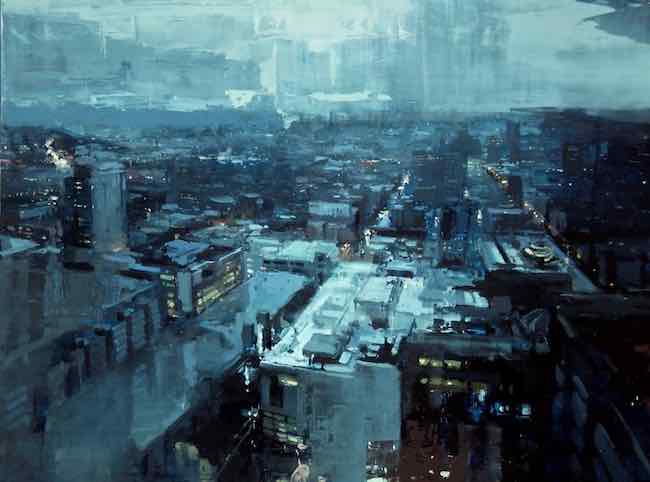L’osservazione di ciò che appartiene alla contemporaneità è una caratteristica che contraddistingue gli artisti attuali, alcuni spingendosi nelle profondità dell’irrazionale e dell’inafferrabile attraverso un linguaggio decisamente indefinito per indurre la mente e l’istinto ad approfondire i concetti espressi, altri invece lasciando vagare lo sguardo sulla realtà circostante da cui poi evincere quei significati nascosti che a una prima occhiata sembrano sfuggire. Tra questa seconda categoria di creativi esiste chi mostra un approccio più sognante e orientato alla contemplazione di panorami che permettono di lasciarsi andare al contatto con la natura, e altri che invece preferiscono raccontare il fascino di quella metropolitanità costituente la realtà in cui si trovano a vivere ogni giorno. Il protagonista di oggi appartiene a questa seconda categoria di artisti.
Intorno alla fine del Diciannovesimo secolo emerse un vento innovativo nel mondo dell’arte, un principio da cui si sarebbero poi sviluppate tutte le avanguardie che avrebbero caratterizzato il secolo successivo; la prima rottura netta con il passato accademico fu intrapresa da un movimento che, seppur ancora legato alla forma e all’equilibrio estetico, si impose come un nuovo modo di concepire la pittura. L’Impressionismo, questo il nome della corrente che cambiò irrimediabilmente tutto, voleva infatti fermare l’istante dipingendolo nel momento in cui l’artista vi si trovava davanti, catturandone la luce, il movimento delle acque o delle foglie degli alberi, senza eseguire alcun disegno e terminando l’opera nell’arco di poche ore. Va da sé che una tale velocità di realizzazione richiedesse un approccio completamente differente ai colori che non potevano più essere applicati a più strati, sfumati, e ritoccati prima di ottenere il risultato finale, bensì era necessario trovare un modo inedito di dipingere, quello contraddistinto da piccoli frammenti, o macchie di tonalità differenti che accostate le une alle altre riuscivano a riprodurre le mille sfaccettature delle luci e dei colori reali. Le impressioni erano dunque molto più intense, avvolte da un’aura poetica e irreale che si rendeva più visibile e nitida allontanandosi dalla tela che al contrario da vicino perdeva definizione e i confini tra le figure che facevano parte della composizione. Claude Monet, Alfred Sisley, Pierre Auguste Renoir non solo presentarono al mondo un nuovo modo di fare arte ma lasciarono anche spaccati di vita di quella borghesia emergente che trovava nel vivere all’aria aperta un’inedita piacevolezza, un modo migliore di godere della bellezza della natura ma anche delle città che proprio in quell’epoca si stavano trasformando e lentamente assumendo l’aspetto che le avrebbe contraddistinte nel Ventesimo secolo. La medesima capacità di osservare e raccontare la magia delle strade cittadine fu ripresa molti anni dopo da una parte degli artisti del Realismo Americano, in particolare da George Bellows che amava ritrarre scorci della vita delle città osservando la moltitudine di persone che ogni giorno si affollavano operose nelle vie, nei teatri, in tutte le attività sociali offerte dalle grandi città. In questo grande artista non vi era l’analisi della solitudine, l’approccio esistenzialista dell’altro maestro del Realismo Americano, Edward Hopper, al contrario Bellows osservava rapito la bellezza del via vai vitale appartenente al nuovo mondo che si stava delineando, non si soffermava sulla nuova classe media bensì il suo sguardo indugiava sul popolo, sulla massa che doveva darsi da fare per vivere e sopravvivere.
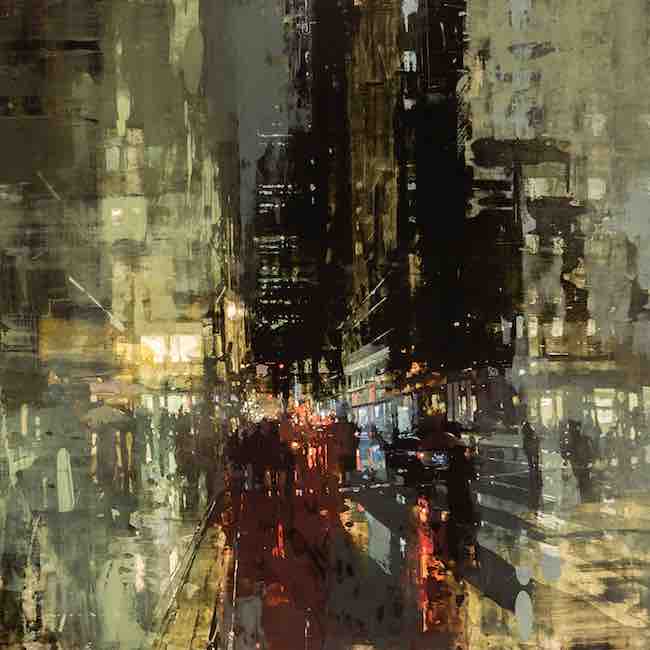
A sua volta statunitense, il giovane artista Jeremy Mann assorbe l’eredità del Realismo Americano fondendola alla frammentazione del tocco pittorico e della luce caratteristica dell’Impressionismo di cui però cambia i soggetti, li adatta alla contemporaneità mostrando la sua predilezione per la globalità di tutto ciò che quotidianamente scorre sotto i suoi occhi, escludendo il dettaglio e la presenza umana se non sotto forma di traffico, di costante flusso di persone che ogni giorno riempiono le strade delle metropoli seppure senza apparire, nascosti dentro le loro auto, impegnati a vivere la loro vita senza osservare la bellezza di ciò che li circonda. Mann si lascia rapire dalle luci, dai riflessi che i fanali delle auto e delle luci dei negozi che si imprimono sullo sguardo quasi come fossero una scia, comete luminose che illuminano la notte come il giorno, senza soluzione di continuità.
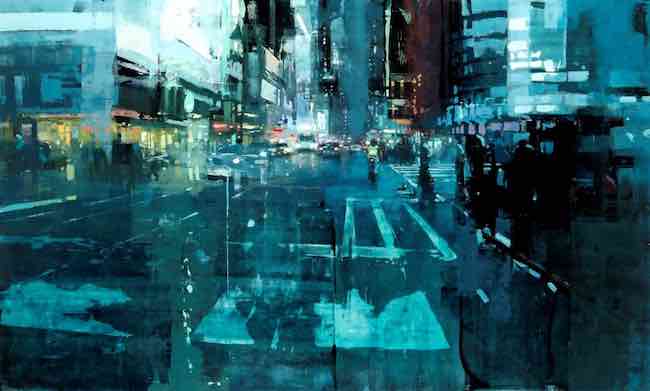
La sua tecnica è sperimentale poiché se da un lato ripropone la frammentazione cromatica, seppur di dimensioni più ampie rispetto alla pennellata impressionista tradizionale, attraverso la quale riesce a riprodurre l’incanto della rifrazione della luce e dei riflessi che si allungano lungo le strade contornate da grattacieli, dall’altro il suo è uno studio costante, contraddistinto non più dalla pittura en plein air bensì dalla cattura dell’immagine per cui sente ispirazione attraverso la macchina fotografica e solo in un secondo tempo, dopo lo sviluppo e il tentativo di sovrapposizione degli scatti attraverso lenti a pellicola, sceglie quella che sarà la veste definitiva dell’opera che andrà a realizzare.
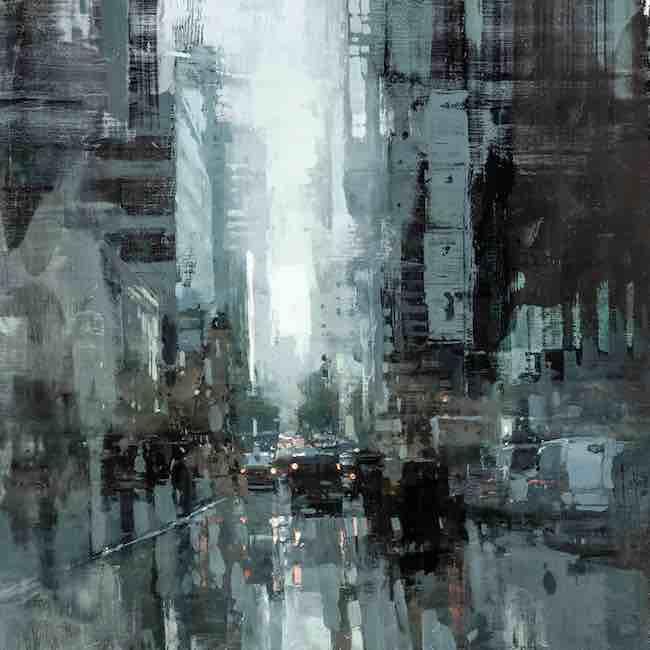
I giorni ritratti da Mann sono costantemente avvolti da una luce azzurrina o gialla, come se fossero immortalati all’alba o al crepuscolo, mentre le notti non sono mai buie piuttosto piene delle coinvolgenti luci delle città che tutto mettono in evidenza ma molto nascondono. È proprio questo il punto in cui si insinua la ricerca filosofica e la riflessione antropologica di questo talentuoso artista, uno sguardo sulla società contemporanea troppo distante dal contatto umano, troppo orientata al correre dietro al bisogno di tornare a casa e poi a quello di uscirvene, per essere in grado di assaporare in pieno ogni frangente.
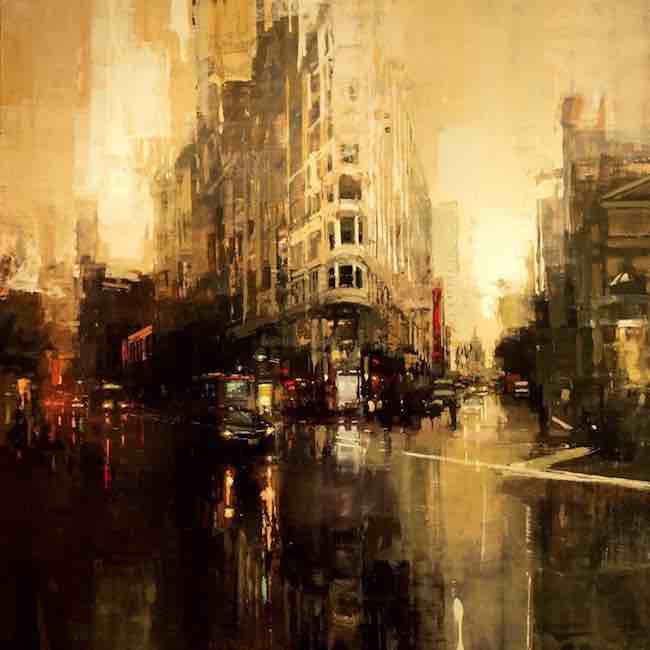
Dunque l’artista diviene specchio di quella realtà, invitando l’osservatore in un primo momento a lasciarsi ammaliare dalla cristallina bellezza di quegli scorci urbani che si mostrano nella loro veste più lucente, e poi invece a riflettere e domandarsi perché non vi sia presenza umana se non nel movimento delle auto che sembrano marcare il tempo della velocità di un vivere dimentico di soffermarsi a essere, a fermare l’attimo per fare il punto sulla situazione, senza perdersi dietro tutto ciò che c’è da fare invece che chiedersi per quale motivo sia necessario avere tutta quella fretta di andare in qualche luogo diverso da quello in cui si è.
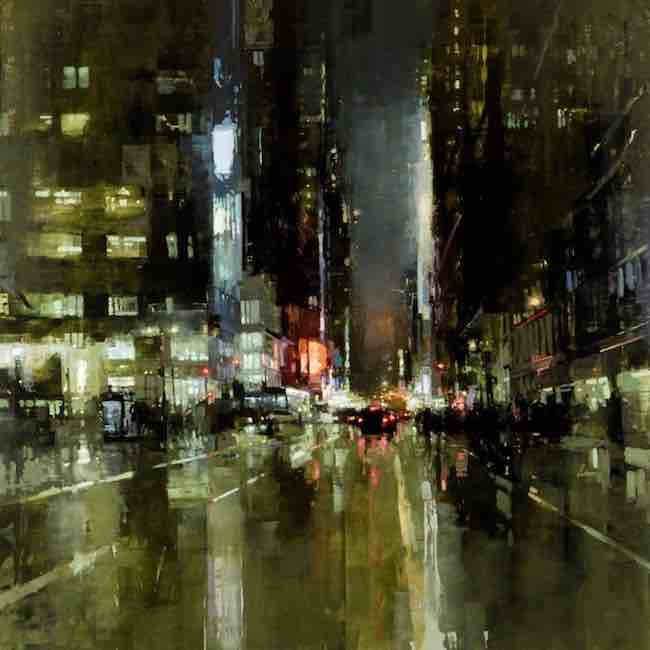
Ma i paesaggi più metropolitani e fascinosi sono quelli notturni, quando le luci diventano più intense, i palazzi che sovrastano le larghe vie di New York o di Los Angeles sembrano porsi in silenziosa osservazione di tutto ciò che si muove in basso, di quella vitalità osservata da lontano molto simile al punto di vista dell’artista, esterno ai suoi paesaggi urbani, come se in qualche modo volesse mantenersi al di fuori da quei ritmi ma senza restare indifferente all’attrattiva che inevitabilmente essi esercitano su chiunque. Le strade riflettono le luci come se fossero superfici specchianti, proprio in virtù del buio, dell’ombra che è una costante ma che concede al bagliore delle insegne, delle vetrine dei negozi, dei semafori e dei fanali delle automobili di irrompere e disturbare il suo manto; ed è esattamente in quel frangente che si manifesta la vita metropolitana con tutta la sua irruenza, la sua vitalità, la sua attrattiva che conquista un turista per caso o un abitante che sa come approfittare in pieno delle mille opportunità delle città che non dormono mai.
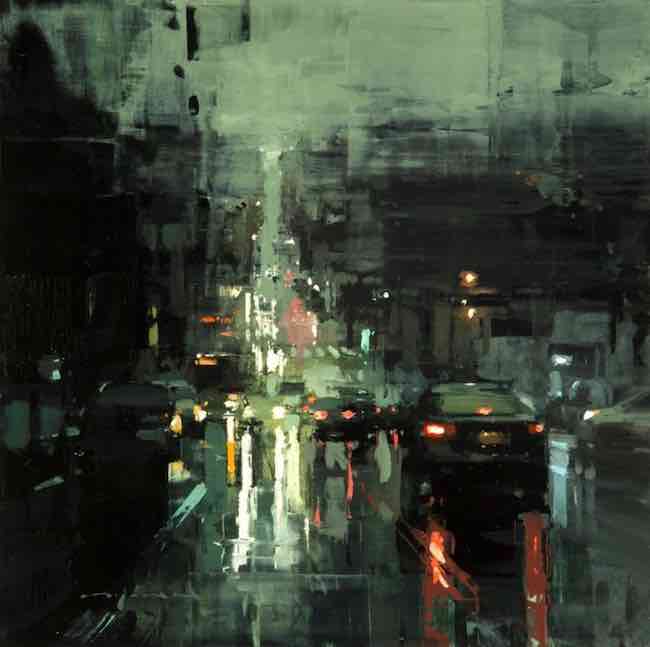
La capacità narrativa di Jeremy Mann si mescola così a una tecnica innovativa, di forte impatto emozionale ed estetico attraverso al quale l’osservatore viene indotto a sentirsi parte di quel mondo, conquistato dal rumore del traffico che, paradossalmente, sembra essere soffuso, ammantato dal silenzio della capacità di contemplazione dell’artista; davanti al glamour delle atmosfere scintillanti di quella dimensione esistenziale a cui egli stesso appartiene infatti, diventa difficile non lasciarsi prendere da quel movimento costante e perpetuo che non si ferma mai, dal richiamo seducente di quel perdersi nella moltitudine che da un lato spaventa ma dall’altro garantisce la possibilità di rimanere sulla superficie, senza spingersi in approfondimenti che a volte spaventano, permettendo di posticipare a un domani non specificato la necessità di affrontare anche ciò che non si vuole affrontare.
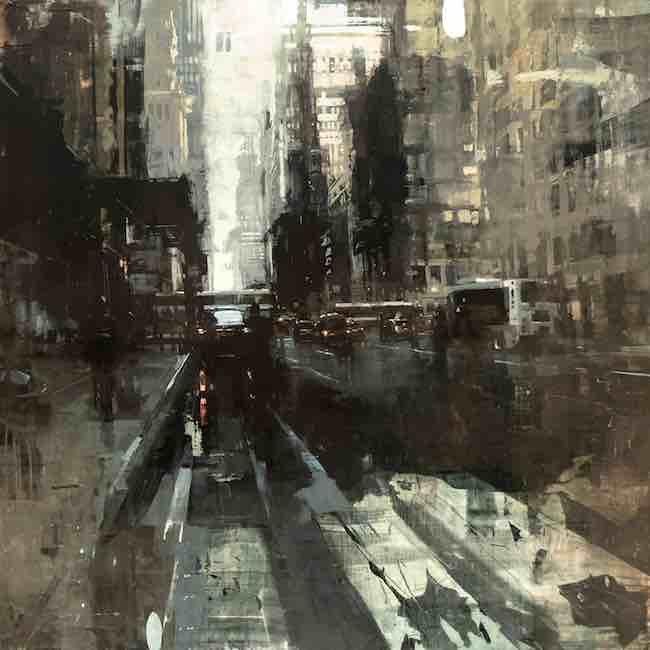
In quel manto luminoso l’individuo non si sente solo come nelle tele di Edward Hopper bensì si immerge in tutte le opportunità che le metropoli offrono anche a costo di mantenersi distante dall’essenziale della vita. Jeremy Mann è uno dei maggiori talenti statunitensi, influente e quotato, vanta collezionisti in tutto il mondo ed è relatore in workshop internazionali di arte. È rappresentato da diverse gallerie in vari stati nordamericani e in Italia dalla Galleria Piero della Francesca di Arezzo.
JEREMY MANN-CONTATTI
Email: galleriapierodellafrancesca@gmail.com
Sito web: https://redrabbit7.com/
Facebook: https://www.facebook.com/JeremyMannART
Instagram: https://www.instagram.com/redrabbit7/
Lights and Shadows of United States Cities in Jeremy Mann’s Urban Neo-Impressionism
The observation of what belongs to the contemporary world is a characteristic that distinguishes today’s artists, some pushing into the depths of the irrational and the elusive through a decidedly indefinite language to induce the mind and instinct to deepen the concepts expressed, others instead letting their gaze wander over the surrounding reality from which they then evince those hidden meanings that at first glance seem to escape. Among this second category of creatives, there are those who show a more dreamy approach, oriented towards the contemplation of panoramas that allow them to let themselves go in contact with nature, and others who instead prefer to recount the charm of that metropolitanity that constitutes the reality in which they find themselves living every day. Today’s protagonist belongs to this second category of artists.
Around the end of the 19th century, an innovative wind emerged in the world of art, a principle from which all the avant-gardes that would characterise the following century would develop; the first clear break with the academic past was undertaken by a movement that, although still tied to form and aesthetic balance, imposed itself as a new way of conceiving painting. Impressionism, this is the name of the movement that changed everything irrevocably, wanted to stop the moment by painting it in the instant the artist was in front of it, capturing the light, the movement of the water or the leaves of the trees, without making any drawings and finishing the artwork within a few hours. It goes without saying that such a speed of realisation required a completely different approach to colours, which could no longer be applied in several layers, shaded, and retouched before obtaining the final result, but rather it was necessary to find a new way of painting, one characterised by small fragments, or patches of different tones that, when placed side by side, were able to reproduce the thousands of facets of real light and colour. The impressions were therefore much more intense, enveloped in a poetic and unreal aura that became more visible and sharper as one moved away from the canvas, which on the contrary lost definition and the boundaries between the figures that were part of the composition up close. Claude Monet, Alfred Sisley and Pierre Auguste Renoir not only presented the world with a new way of making art, but also left behind glimpses of the life of the emerging bourgeoisie that found in living in the open air an unprecedented pleasure, a better way of enjoying the beauty of nature but also of the cities that were being transformed at the time and slowly taking on the appearance that would distinguish them in the 20th century.
The same ability to observe and narrate the magic of the city streets was taken up many years later by some of the artists of American Realism, in particular by George Bellows who loved to portray glimpses of city life by observing the multitude of people who crowded industriously every day in the streets, in the theatres, in all the social activities offered by large cities. In this great artist, there was no analysis of loneliness, no existentialist approach of the other master of American Realism, Edward Hopper, on the contrary, Bellows observed, enraptured, the beauty of the vital bustle belonging to the new world that was taking shape; he did not dwell on the new middle class, but his gaze lingered on the people, on the masses who had to work to live and survive. Also from the United States, the young artist Jeremy Mann absorbed the legacy of American Realism, merging it with the fragmentation of the painterly touch and light characteristic of Impressionism, of which, however, he changed the subjects, adapting them to contemporaneity, showing his predilection for the globality of everything that passes daily before his eyes, excluding detail and human presence except in the form of traffic, of the constant flow of people who fill the streets of metropolises every day without appearing, hidden inside their cars, busy living their lives without observing the beauty of their surroundings.
Mann allows himself to be enraptured by the lights, by the reflections that the headlights of cars and shop lights imprint on his gaze almost as if they were a trail, luminous comets that light up the night as well as the day, without interruption. His technique is experimental because if on the one hand he re-proposes chromatic fragmentation, albeit on a larger scale than the traditional Impressionist brushstroke, through which he manages to reproduce the enchantment of the refraction of light and the reflections that stretch along the streets lined with skyscrapers. On the other hand, his is a constant study, characterised no longer by en plein air painting but by the capture of the image for which he feels inspiration through the camera and only later, after the development and the attempt to superimpose the shots through film lenses, does he choose what will be the final look of the artwork he will create. The days portrayed by Mann are constantly shrouded in a blue or yellow light, as if immortalised at dawn or dusk, while the nights are never dark but rather full of the enthralling city lights that highlight everything but conceal much. This is precisely the point at which the philosophical research and anthropological reflection of this talented artist insinuates itself, a look at contemporary society that is too distant from human contact, too oriented towards running after the need to return home and then the need to get out of it, to be able to fully savour every juncture. So the artist becomes a mirror of that reality, inviting the observer at first to let himself be enchanted by the crystalline beauty of those urban glimpses that show themselves in their most shining guise, and then instead to reflect and ask himself why there is no human presence except in the movement of the cars that seem to mark the time of the speed of a living that forgets to pause to be, to stop the moment to take stock of the situation, without getting lost in all that there is to do instead of wondering why it is necessary to be in such a hurry to go somewhere other than where one is.
But the most metropolitan and fascinating landscapes are those at night, when the lights become more intense, the buildings towering over the wide streets of New York or Los Angeles seem to stand in silent observation of everything that moves below, of that vitality observed from afar very much like the artist’s point of view, external to his urban landscapes, as if somehow wanting to remain outside those rhythms but not indifferent to the attraction they inevitably exert on everyone. The streets reflect the lights as if they were mirrored surfaces, precisely because of the darkness, the shadow that is a constant but which allows the glow of the signs, shop windows, traffic lights and car headlights to break through and disturb its mantle; and it is precisely at that juncture that metropolitan life manifests itself with all its impetuosity, its vitality, its attractiveness that conquers a tourist by chance or an inhabitant who knows how to take full advantage of the thousands of opportunities of the cities that never sleep. Jeremy Mann’s narrative ability is thus mixed with an innovative technique of strong emotional and aesthetic impact through which the observer is induced to feel part of that world, conquered by the noise of the traffic that, paradoxically, seems to be suffused, cloaked by the silence of the artist’s ability to contemplate; in front of the glamour of the glittering atmospheres of that existential dimension to which he himself belongs, it becomes difficult not to let oneself be taken in by that constant and perpetual movement that never stops, by the seductive call of that losing oneself in the multitude that on the one hand frightens but on the other guarantees the possibility of remaining on the surface, without going into depths that sometimes frighten, allowing one to postpone to an unspecified tomorrow the need to face even that which one does not want to face. In that luminous mantle, the individual does not feel lonely as in Edward Hopper’s canvases, but rather immerses himself in all the opportunities that the metropolis offers, even at the cost of keeping his distance from the essentials of life. Jeremy Mann is one of the most talented and influential artists in the USA, has collectors all over the world and is a speaker at international art workshops. He is represented by several galleries in various North American states and in Italy by the Galleria Piero della Francesca in Arezzo.


